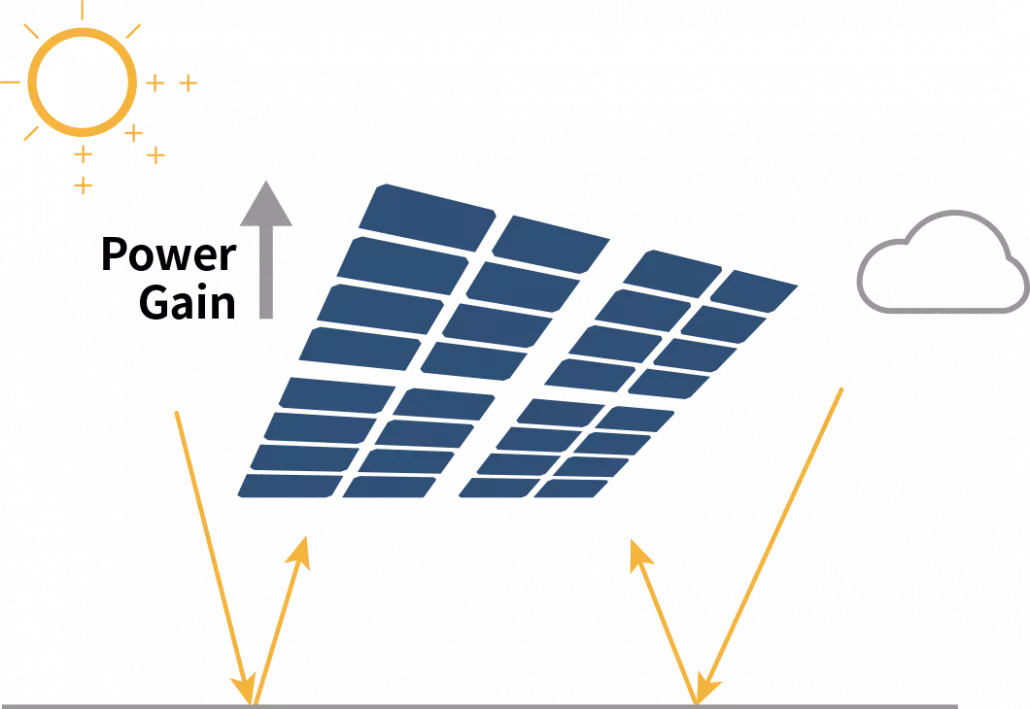PERC Cell
The PERC cell has a passivated rear side and a laser grooving process, which significantly improves the cell efficiency.
Bifacial PERC
For a bifacial PERC cell, the Al back surface field is replaced by Al grid, hence render the majority of rear side transparent which enable the cell to absorb light and generate electricity from both sides.
High Energy Yield
Outstanding low irradiance performance, low power-temperature coefficient, low operating temperature, all these technologies lead to a high energy yield.
Warranty
Based on the advanced mono wafer and anti-LID technology, We offers a first-year power warranty of ?98% for PV modules.
Cell Efficiency in
Mass Production
1st Year Degradation,
Anti-LID
Outstanding Low
Irradiance
Performance
Low Power
Temperature
Coefficient
Bifacial Power Generation
The energy yield of bifacial module can be influenced by albedo, height of module, GCR and DHI etc. Installation height of bifacial module is recommended to be higher than 1m. Shading from bracket and junction box should be avoided. At present, the power generation of bifacial module on fixed brackets and single axis tracker can be simulated with PVsyst. Investors can determine the DC/AC ratio of bifacial module system to minimize the LCOE.
Albedo
It has considerable gains
on grass land, dry sand,
especially in snowfield
Module Height
High module height will
reduce the shading
impact on rear side. A
minimum of 1m is
recommended
GCR
A low GCR will increase
radiance on the rear side
DHI
Diffuse light can be
absorbed by the rear
side of the module. the
higher proportion of
Diffuse light, the higher
is the bifacial gain
Half-Cut Technology
Half-cut cell technology is to cut the cell into two seperate parts by mature infrared laser, hence halve the working current. The thermal loss on the ribbon will be remarkably reduced and the module’s power increases by 2%. The reliability of module is also enhanced.
The combination of half-cut cell technology and bifacial module can amplify the gain over the effect of current-reduction.
Hot Spot Temperature
In field applications, small area shadings can cause the temperature of those parts extremely high. This phenomena is called hot spot. The long duration of hot spot could bring irreversible degradation of modules.
Because the string current of half-cell modules is half of full-cell modules, the hot spot temperature can be obviously reduced. The experiments show that this reduction could be 10-20°C, which increases the module reliability.
Lower Operating Temperature
Half-cut cells have half of the working current, thereby the thermal loss is remarkably reduced. Operating temperature correspondingly decreases, and the reliability of module is improved as well as power gain.
Lower Shading Loss
Because of the unique parallel connection design, half-cell modules still have 50% power output under the circumstance of array shading in sunrise or sunset when portrait installation.
In addition, half-cut technology can improve the output of bifacial module under non-uniform incident illumination on the backside.
Higher Energy Yield Under High Irradiation Condition
Under high irradiation conditions, half-cell module, especially bifacial half-cell module, will have a higher energy yield compared with conventional module. Bifacial half-cell module will help to achieve the lowest LCOE in regions which is rich in sun radiation resources.






















